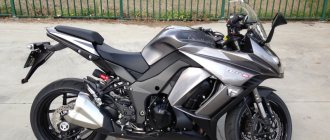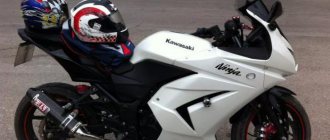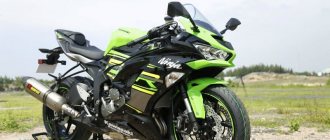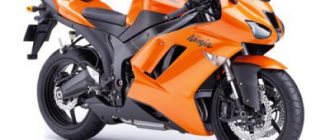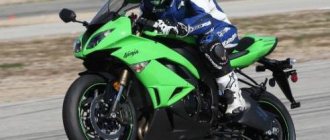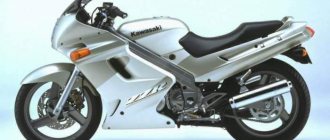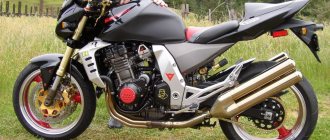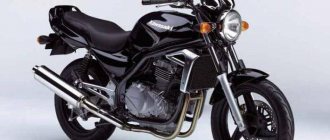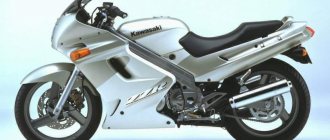| Kawasaki Ninja 300 (2013-2017) |
Model of the budget sports motorcycle Kawasaki Ninja 300
appeared on the market by 2013, replacing the Kawasaki Ninja 250R model in Europe, North America, etc. By the way, the Ninja 250R model was also updated by 2013 and received the name Ninja 250, continuing to be sold in Japan and a number of other countries. Visually and almost completely technically, the Ninja 250 and Ninja 300 models are identical and differ only in engines.
The Kawasaki Ninja 300 engine is a 2-cylinder in-line liquid-cooled unit with a displacement of 296 cc and produces 39 hp. power and 27 Nm of torque. This engine was subsequently also installed on such models as the Kawasaki Z300 and Kawasaki Versys-X 300.
In terms of chassis, the Kawasaki Ninja 300 is equipped with a steel frame, simple suspension in the form of a conventional 37 mm telescopic fork and a monoshock absorber (adjustable by preload), 2-piston disc brakes (versions with ABS available), a slipper clutch and a 6-speed gearbox.
Unlike the Kawasaki Ninja 250R, the Ninja 300 model received a slightly smaller fuel tank (17.8 l -> 17.0 l) and an increased curb weight (169 kg -> 172 kg, versions with ABS - 174 kg).
2017 was the last year of production of the Kawasaki Ninja 300, after which it rolled off the assembly line, giving way to a new version - the Kawasaki Ninja 400. In turn, the Kawasaki Ninja 250 did not leave the market, but received a number of visual and technical updates - in particular, increased to 39 hp maximum engine power comparable to the Ninja 300.
The main competitors of the Kawasaki Ninja 300 in the class:
- Yamaha YZF-R3
- Honda CBR 300
Brief history of the model
- 2013 - start of production and sales of the Kawasaki Ninja 300 model.
Model
: Kawasaki Ninja 300;
Kawasaki Ninja 300 ABS (Europe, North America, etc.). Factory designation
: EX300ADF, EX300ADFA; EX300BDF, EX300BDFA.
- 2014 - no significant changes.
Model
: Kawasaki Ninja 300;
Kawasaki Ninja 300 ABS (Europe, North America, etc.). Factory designation
: EX300AEF, EX300AEFA; EX300AES, EX300AESA; EX300BEF, EX300BEFA; EX300BES, EX300BESA.
- 2015 - no significant changes.
Model
: Kawasaki Ninja 300;
Kawasaki Ninja 300 ABS (Europe, North America, etc.). Factory designation
: EX300AFF, EX300AFFA; EX300AFS, EX300AFSA; EX300BFF, EX300BFFA; EX300BFS, EX300BFSA.
- 2016 - no significant changes.
Model
: Kawasaki Ninja 300;
Kawasaki Ninja 300 ABS (Europe, North America, etc.). Factory designation
: EX300AGF, EX300AGFA; EX300BGF, EX300BGFA.
- 2017 is the last year of production.
Model
: Kawasaki Ninja 300;
Kawasaki Ninja 300 ABS (Europe, North America, etc.). Factory designation
: EX300AHF, EX300AHFA;
EX300BHF, EX300BHFA.
Who is it suitable for?
For a beginner - 100%. Leave the boring 125s and 200s to the kids. If you want to start your first season with something normal, buy a Kawasaki Ninja 300. First of all, because once you start riding normal equipment, you will get the whole gamut of positive emotions that a motorcycle can give. This is not a product of the Chinese market, but a space shuttle on the road.
In addition, the Kawasaki Ninja 300 has excellent maximum speed and dynamics, so you won’t be trailing behind the flow, turning the gas to full, but leading it.
For an experienced biker - yes. If you read some of the reviews about the Kawasaki Ninja 300, it will become clear why motorcyclists with many years of experience buy it – it’s a pleasure. Moving around the city on such a motorcycle, even an elderly motorcyclist will receive pure joy from the good response to the throttle, the amazing agility of the motorcycle and the ridiculous consumption, in comparison with motorcycles with a capacity of 600 cc.
Specifications
Technical characteristics of Kawasaki Ninja 300:
| Model | Kawasaki Ninja 300 |
| Motorcycle type | sport |
| Year of issue | 2013-2017 |
| Frame | steel diagonal |
| engine's type | 2-cylinder, 4-stroke, in-line |
| Working volume | 296 cm³ |
| Bore/Stroke | 62.0 x 49.0 mm |
| Compression ratio | 10.6:1 |
| Cooling | liquid |
| Number of valves per cylinder | DOHC, 4 valves per cylinder |
| Fuel supply system | Injector with dual butterfly valves, 2x 32 mm |
| Ignition type | transistor |
| Maximum power | 39.0 hp (29.0 kW) at 11000 rpm |
| Maximum torque | 27.0 Nm (2.8 kg*m) at 10,000 rpm |
| Clutch | Multi-disc in oil bath, cable drive |
| Transmission | 6-speed |
| type of drive | chain |
| Front tire size | 110/70-17M/C (54S) |
| Rear tire size | 140/70-17M/C (66S) |
| Front brakes | 1 disc, 290 mm, 2-piston caliper - (optional - ABS) |
| Rear brakes | 1 disc, 220 mm, 2-piston caliper - (optional - ABS) |
| Front suspension | Telescopic fork 37 mm (non-adjustable), travel - 120 mm |
| Rear suspension | Pendulum Uni-Trak with monoshock absorber (5-stage adjustable preload), stroke - 132 mm |
| Motorcycle length | 2015 mm |
| Motorcycle width | 715 mm |
| Motorcycle height | 1110 mm |
| Wheelbase | 1405 mm |
| Seat height | 785 mm |
| Minimum ground clearance | 140 mm |
| Acceleration 0-100 km/h (0-60 mph) | 6.41 sec[1] |
| Maximum speed | 170 km/h[2] |
| Gas tank capacity | 17.0 l |
| Motorcycle weight (curb) | 172 kg – Ninja 300 174 kg – Ninja 300 ABS |
Competitors
The Yamaha YZF-R3 is practically the twin brother of the Kawasaki Ninja 300, this is clearly visible in the photo. The motorcycles are very similar ideologically, but the Yamaha has a slightly larger engine, which means better acceleration by a fraction of a second and a 10 km/h better top speed.
Honda CBR 300 is another budget sportbike. The smaller volume makes the Honda slightly slower on a straight line, but excellent torque and low weight allow it to show good dynamics.
Comparing the Kawasaki Ninja 300 technical specifications with the presented competitors, we will find that the motorcycles are very similar and it will be possible to find a winner only in a head-to-head bet.
Reviews
Kawasaki Ninja 300 reviews:
Expand Collapse
The handling of this motorcycle is simply excellent. One day we were riding around the city, and all my friends had “liter” motorcycles. Then we stopped to “gnaw on some seeds.” And everyone asked to ride on my motorcycle. And everyone said that it was controlled like a toy. Very responsive, predictable. It turns into turns like a cast car. It won't be able to slip out from under you. No matter how I tried to drop it, it didn’t work. What I didn’t do: and on cones when we learned to ride. It was wobbling back and forth, but it was standing on wheels and that was it. And he drew circles and figure eights, and at idle speed. Well, the moto doesn't fall. At least get up and lay it on its side by the handle))))) And at speeds over 120 km/h nothing is torn off by the oncoming air flow. Maybe because of my short height. Don't know. The back and neck are not stiff. The landing is smooth.
There is a sensor on the motorcycle, which, in my opinion, is called the clutch on or off sensor. It is located under the clutch handle. It allows you to start the motorcycle in first gear with the clutch fully depressed. Well, this is a very weak point for these motorcycles. There, either the wiring is frayed, or the sensor itself is oxidized. In general, you have to put it in neutral every time to start the engine. Inconvenient.
For the first bike, I haven’t seen a better one yet, if you like sport bikes, it’s a cool motorcycle for such a price, especially since it’s a new bike, at that kind of money, among its more powerful brothers, it’s only junk, both morally and realistically. Not bad dynamics considering that this is a 250, no worse than the previous four hundred. Well, the overall appearance is 5+, my friends are engaged in tuning sports bikes from 98-2005, they belittled me to leave them for a few days to make a cast, nothing more beautiful has been invented yet. Very comfortable for a beginner, almost straight, landing. Forgives many mistakes. Of the minuses: although it accelerates to 160, after 100 it is very sluggish and after 80 it’s scary to overtake, I was simultaneously riding a Suzuki 650, such fears did not arise even after 130, I unscrewed it and drove off. But if you compare it with a car, (to make it clearer) of course the 250r is faster than any average car, so for the first bike it’s not too much of a minus, and maybe even a plus. The second disadvantage is much more serious, but it manifests itself if your height is more than 185 cm.
Engine
The main changes affected the motorcycle's power unit .
It was based on the engine of its predecessor, whose displacement was increased to 293 cm3. Engine power 39 hp and a torque of 27nM are achieved at about 10,000 rpm, which is slightly higher than that of its predecessor.
The maximum engine speed is similar to that of the class founder and is 13,000 rpm.
But these speeds are achieved without compromising the elasticity of the engine thanks to the installed fuel injection system with two throttle valves. This is also facilitated by special settings of the injection control unit.
has enviable acceleration from 100 km/h , which puts it on par with motorcycles with larger engines.
The new engine is expected to significantly increase its service life due to the use of new lightweight pistons with a short skirt and low-wear Alumite coating.
The exhaust sound of the new product is regulated by a new 2-in-1 exhaust system, in which the diameter of the exhaust pipe and its length are increased, and the muffler itself has a shortened length and a new lining to prevent burns to the rear passenger's legs.
The new generation motorcycle, unlike the Ninja 250, which could be equipped with both a carburetor and fuel injection, has only the latter version of the fuel system.
Each cylinder has two throttle valves that have different controls.
If one is controlled by the throttle, the second is controlled exclusively by the control unit, depending on the engine operating modes.
As a result of this combined effect on the fuel mixture, the motorcycle has good pickup and the highest possible acceleration at any speed.
A characteristic feature of the engine is easy starting in any weather conditions. And all these processes occur with low fuel consumption.
The new Ninja has excellent speed performance. Its maximum speed is recorded at 170.6 km/h, and acceleration to “hundreds” is achieved in 5.6-6.4 seconds.
The Ninja 300 package boasts water cooling with a specially configured fan shroud, which, together with a plastic body kit, helps cool the fuel tank and frame elements of the motorcycle, while simultaneously removing the flow of hot air from the area in which the rider is located.
Simple and lightweight, compact and powerful – these are the main criteria that guided the company when creating the Yamaha-R6, the characteristics of which you will find here.
The history of the manufacturer of this motorcycle knows examples when one or another model with average characteristics turned into a bestseller, a legend on a global scale.
Origin of the company
When you talk about a vehicle like a Kawasaki, you immediately think of a fast and high-quality sports motorcycle. Although initially the main activity of this company was shipbuilding.
This is a Japanese corporation that began its activities in 1896. Today it is one of the world's largest industrial concerns. Currently, the presented manufacturer occupies a leading position in the production of the following products:
- jet skis;
- tractors;
- trains;
- engines;
- small planes;
- helicopters.
Also one of the priority areas is the production of motorcycles and all-terrain vehicles. The company is also engaged in the construction of industrial enterprises and power installations of equipment. Headquarters are located in the cities of Kobe and Tokyo.
Chassis
The motorcycle is comfortable and easy to ride, both in urban conditions and on the highway.
The only disadvantages are that at maximum speed the fairings work well only if the driver is pressed against the tank, and that due to the light weight and high side windage of the body kit, the bike is sensitive to side gusts of wind.
Ride comfort is also ensured by the Uni Track rear single-link suspension with a manually adjustable variable stiffness shock absorber.
A comfortable anatomically shaped seat and adjusted distance to the steering wheel allows the motorcyclist to take an almost classic riding position, which contributes to comfortable trips over long distances.
The chassis has changed little , only the front fork settings have changed.
Slightly wider wheels, and the Ninja 300 has 110/70 and 140/70 wheels, respectively, front and rear with a diameter of 17 inches, contribute to more stable behavior of the motorcycle in corners.
Optionally, the motorcycles come with an anti-lock brake system, which adds little to the price of the motorcycle, but is fully justified when driving on slippery surfaces.
A modified panel allows you to control the operating modes of the power unit and the movement of the motorcycle. The panel provides digital speedometer, tachometer, day and trip meters, clock and environmental indicator for monitoring.
Verdict
2017 is the year when the Hyosung GD250R reached our shores and burst into the hot 250cc motorcycle market. There are already many manufacturers exhibiting their small-sized motorcycles here, which will provide tough competition to the GD250R. Traditionally, this market is ruled by Honda, Yamaha and Kawasaki. Later, KTM burst in there, grabbing its share of sales.
The launch of the GD250R is like a breath of fresh air for Hyosung. Externally, it has something in common with many liter bikes and has a redesigned engine. Oh, if only he were really as good as he looks. Unfortunately, it loses to its competitors on almost all fronts.
Sorry Hyosung, but you should try harder.
Where to store Kawasaki Ninja in winter
Winter maintenance of a motorcycle is quite a troublesome task. It is better if the garage is heated. At the same time, it must be clean and dry. The motorcycle should be carefully prepared for winter:
- wash thoroughly using plastic shampoo;
- apply polish and wax to the surface;
- rubber parts are treated with silicone spray, and metal parts are treated with WD-40;
- Fully fill the tank with high-quality gasoline;
- it is necessary to seal the muffler, which will protect it from condensation;
- remove the battery and place it in a warm place, recharging it regularly;
- half deflate the tires to prevent them from cracking during storage;
- cover the motorcycle with a cover on top;
Do not cover your motorcycle with plastic wrap. There is no need to drain the oil, as this will cause rusting of the internal surfaces. It is also not worth draining the liquid from the cooling system.
If all these points seem too complicated, you can entrust the wintering of the iron horse to professionals. All you have to do is contact any moto service and you can be sure that nothing will happen to your motorcycle. All storage rules will be observed, and you can observe how they are followed throughout the winter. In the spring, a clean and serviceable motorcycle will be waiting for its owner. For an additional fee, specialists will conduct a full diagnosis of all components and mechanisms, give recommendations for correcting faults, charge the battery, and replace the filter and oil.
Updated samurai
This is how we can briefly describe the Ninja 300 - a modernized 250 model, the history of which begins in 2012, when the Japanese creators decided to release a sports and at the same time inexpensive motorcycle. The machine is characterized by an injection engine, an enlarged cylinder and a modernized lightweight piston.
The engine capacity has also undergone changes, which has increased significantly compared to the previous model and amounted to 296 cubic meters. cm, providing a power of 39 hp. The announced two-cylinder model is also characterized by reduced fuel consumption and an updated ABS system. Kawasaki also took care to equip its new brainchild with high-quality parts and a dense plastic surface, but Korean tires represent its weak point. The design of the model is thought out to the smallest detail, giving the silhouette of the motorcycle an impressive look.
Thanks to its excellent stability and easy gear shifting, the 300 Ninja is perfect for beginners who want to acquire basic motorcycle riding skills, and high-quality disc brakes ensure a safe ride on any road. The motorcycle is specially created for European roads and is capable of reaching speeds of up to 190 km/h.
Owners' opinions
We all know that no matter how beautiful the device looks, before purchasing it, you need to read the reviews of motorcyclists who managed to purchase the model they liked. Owners characterize Ninja bikes as a very fast option, capable of accelerating up to 180 km/h, so they recommend spending money on buying a helmet
Some car enthusiasts note the rather expensive spare parts for Kawasaki and focus on safety, because driving over 150 km/h can only be accomplished by experienced bikers. Others do not notice the shortcomings at all, praising the motorcycle’s fast acceleration and low fuel consumption
When purchasing one of the Kawasaki bikes, you must remember that you are getting a high-quality motorcycle from a reliable Japanese manufacturer that will be able to meet all your expectations, delivering only positive emotions from owning the machine.
Control and maneuverability
The Kawasaki Ninja ZX-6R motorcycle has a bold and aggressive appearance.
Its weight is reduced, the exhaust pipe is short, and the chassis design has undergone major changes.
As for the power unit, it has also undergone significant modernization.
Its maximum balance allows for much better power transmission at different operating speed ranges.
Therefore, we can say that the Ninja 600 was created specifically for track competitions. The latest equipment has been installed here.
The engine contains magnesium parts, and this has a positive effect on the weight of the two-wheeled unit.
The unique design, which was worked on by the best engineers in the world, allows the biker to easily negotiate turns while moving at high speed.
The rider's reaction is quickly taken into account by the motorcycle. This is facilitated by the ideal balance of the suspension and frame rigidity.
It uses the latest fork with tuning elements, as well as a proprietary steering damper.
But that is not all. Strong radial brake calipers and a sliding clutch design make handling even easier.
Transmission
The basic package is also characterized by the fact that it includes the installation of a clutch made using racing motorcycle technologies.
The slipper clutch controls rear wheel slip during heavy engine braking at high speeds, making riding safer and more comfortable.
In addition, this type of clutch has a softer clutch lever when pressed.
The motorcycle transmission, as it was, remained six-speed. However, a very useful function has been added to its operation - automatic engagement of neutral gear when the motorcycle stops .
Motorcycle cost
Currently, the motorcycle is offered at a price of just over five thousand euros or six thousand three hundred dollars.
In rubles, this price approximately corresponds to the range from 330,000 to 340,000 rubles.
The cost on the secondary market very much depends on the condition of the motorcycle, its configuration and other indicators.
For a 2013 model they can ask for a price from 185,000 to 240,000 rubles, a used 2014 Ninja 300 can cost from 250,000 rubles.
The Ninja 300, like its predecessor, is positioned in the two-wheeled market as the first motorcycle for novice riders. This is precisely the task facing the company’s designers.
A motorcycle with a modern appearance, easy control and serious technical characteristics is exactly what a young motorcyclist needs at the initial stage of his passion for two-wheeled vehicles.
In the Kawasaki Ninja 300 model, the designers were able to amazingly combine the traditions of the brand, a high level of ergonomics, easy handling and many useful innovations.
This motorcycle is equally convenient for any trip , both on the streets of a big city and on the highway, winding serpentine roads and race track.
About reliability
As befits a real ninja, reliability here is at a high level.
This is what contributed to the growing popularity of this bike among stunt riders.
A powerful subframe and increased engine resources allow it to withstand serious mechanical loads while performing various stunts.
Early models of these motorcycles had some problems with the motor. Considering that the engine had high speeds, it was quite powerful, but could not provide the required resource life.
Therefore, those choosing a Kawasaki ZX6R from the range of models from the 90s or early 2000s need to take these features very seriously.
Caring for this motorcycle does not require compliance with any special rules.
However, you will have to comply with the basic requirements, which determine timely refueling, checking tires, good engine care, timely oil changes, as well as proper preparation for the winter period.
Tuning Kawasaki Ninja 300
Read other motorcycle reviews Stels Benelli 600 motorcycle review
An example of tuning a Kawasaki Ninja 300. Photo.
Tuning is the improvement of a motorcycle by installing additional devices and components. The process is entirely individual, as each driver tries to add features that are necessary for him personally. A city biker will try to impress with chrome accessories, a tourism enthusiast will take care of improving the optics and windshield. Some people are missing a clock on the dashboard, while others are trying to improve the chassis.
The rapid growth in the popularity of tuning around the world has determined the offer of well-known companies for entire motorcycle modernization kits. Among the Americans you can Fr. She released a tuning kit for the Kawasaki Ninja250 model. The Kawasaki manufacturer began producing original tuning and accessories for its models. Factory Kawasaki parts and tuning will make your motorcycle more comfortable, stylish and faster.
